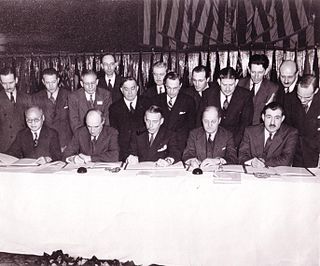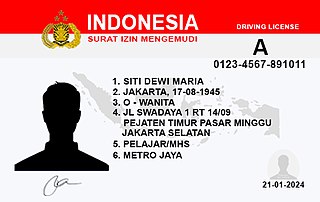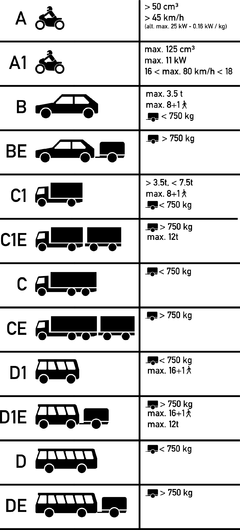
The country in which a motor vehicle's vehicle registration plate was issued may be indicated by an international vehicle registration code, also called Vehicle Registration Identification code or VRI code, formerly known as an International Registration Letter or International Circulation Mark. It is referred to as the Distinguishing sign of the State of registration in the Geneva Convention on Road Traffic of 1949 and the Vienna Convention on Road Traffic of 1968.

The Convention on International Civil Aviation, also known as the Chicago Convention, established the International Civil Aviation Organization (ICAO), a specialized agency of the United Nations charged with coordinating international air travel. The Convention establishes rules of airspace, aircraft registration and safety, security, and sustainability, and details the rights of the signatories in relation to air travel. The convention also contains provisions pertaining to taxation.
A vehicle registration plate, also known as a number plate, license plate or licence plate, is a metal or plastic plate or plates attached to a motor vehicle or trailer for official identification purposes. The registration identifier is a numeric or alphanumeric code that uniquely identifies the vehicle within the issuing authority's database. In Europe most countries have adopted a format for registration plates that satisfies the requirements in the Vienna Convention on Road Traffic, which states that cross-border vehicles must display a distinguishing code for the country of registration on the rear of the vehicle. This sign may be an oval sticker placed separately from the registration plate, or may be incorporated into the plate. When the distinguishing sign is incorporated into the registration plate, it must also appear on the front plate of the vehicle, and may be supplemented with the flag or emblem of the national state, or the emblem of the regional economic integration organisation to which the country belongs. An example of such format is the common EU format, with the EU flag above the country code issued in EU member states.

The Convention on Road Traffic, commonly known as the Vienna Convention on Road Traffic, is an international treaty designed to facilitate international road traffic and to increase road safety by establishing standard traffic rules among the contracting parties. The convention was agreed upon at the United Nations Economic and Social Council's Conference on Road Traffic and concluded in Vienna on 8 November 1968. This conference also produced the Convention on Road Signs and Signals. The convention had amendments on 3 September 1993 and 28 March 2006. There is a European Agreement supplementing the Convention on Road Traffic (1968), which was concluded in Geneva on 1 May 1971.

In Singapore, cars and other vehicles drive on the left side of the road, as in neighbouring Malaysia, due to its British colonial history. As a result, most vehicles are right-hand drive. However, exemptions have been made to allow foreign vehicles and construction machineries to utilise the roadspace of Singapore. As such, vehicles with left hand drive configurations are required to either be driven with a sign indicating "LEFT-HAND-DRIVE" or towed.

The European driving licence is a driving licence issued by the member states of the European Economic Area (EEA); all 27 EU member states and three EFTA member states; Iceland, Liechtenstein and Norway, which give shared features the various driving licence styles formerly in use. It is credit card-style with a photograph. They were introduced to replace the 110 different plastic and paper driving licences of the 300 million drivers in the EEA. The main objective of the licence is to reduce the risk of fraud.
In India, a driving licence is an official document that authorises its holder to operate various types of motor vehicles on highways and some other roads to which the public has access. In various Indian states, they are administered by the Regional Transport Authorities/Offices (RTA/RTO). A driving licence is required in India by any person driving a vehicle on any highway or other road defined in the Motor Vehicles Act, 1988. This act sets limits on the minimum age for vehicle operation ranging from 16 to 20, depending on specific circumstances. A modern photo of the driving licence can also serve many of the purposes of an identity card in non-driving contexts, such as proof of identity or age.
In Pakistan, the driving licence is the official document which authorises its holder to operate various types of motor vehicles on publicly accessible roads. Driving licences can be obtained by submitting an application to any licensing authority in the applicant's district.

The Driving License of the People's Republic of China is the legal driving license in mainland China. It is issued, ratified, and regularly inspected by the traffic administrative department of the public security organ. The minimum age varies from 18 for cars to 26 for large buses.
A driving licence in Singapore is required before a person is allowed to drive a motor vehicle of any description on a road in the country. Like many other countries in the world, an individual must possess a valid driving licence before being permitted to drive on the road, and driving licence holders are subject to all traffic rules.

In the United Kingdom, a driving licence is the official document which authorises its holder to operate motor vehicles on highways and other public roads. It is administered in England, Scotland and Wales by the Driver and Vehicle Licensing Agency (DVLA) and in Northern Ireland by the Driver & Vehicle Agency (DVA). A driving licence is required in England, Scotland, and Wales for any person driving a vehicle on any highway or other "road", as defined in s.192 Road Traffic Act 1988, irrespective of the ownership of the land over which the road passes. Similar requirements apply in Northern Ireland under the Road Traffic Order 1981.

The Convention on Road Traffic, commonly known as the Geneva Convention on Road Traffic, is an international treaty promoting the development and safety of international road traffic by establishing certain uniform rules among the contracting parties. The convention addresses minimum mechanical and safety equipment needed to be on board and defines an identification mark to identify the origin of the vehicle. The Convention was prepared and opened for signature by the United Nations Conference on Road and Motor Transport held at Geneva from 23 August to 19 September 1949. It came into force on 26 March 1952. This conference also produced the Protocol on Road Signs and Signals.
The Inter-American Driving Permit (IADP) is an identity document that licenses the holder to drive a private motor vehicle in another nation when accompanied by a valid license from their home country. The IADP is similar to the International Driving Permit (IDP), but is specific to drivers in North, Central, and South America. To be eligible for an IADP, one must first have a valid driver's license. The IADP might not be issued by all countries in the Americas, due to most of them being parties of the 1949 Geneva Convention or the 1968 Vienna Convention, thus most only issue the IDP.

A driving licence is required in Malaysia before a person is allowed to drive a motor vehicle of any description on a road in Malaysia under the Road Transport Act 1987, section 26(1). Under section 26(1) of the Road Transport Act, an individual must possess a valid driving licence before being permitted to drive on the road, or can be prosecuted under section 26(2). Upon conviction, the miscreant is liable to fines or jail or both. Driving licence holders are subject to all traffic rules stated in the Road Transport Act 1987.

The Indonesian driving license is a legal document required for a person to be allowed to drive a motor vehicle in Indonesia. It is issued by the Indonesian National Police (POLRI), renewable every 5 years, and is valid in all ASEAN member states without an International Driving Permit. Driving license holders are subject to all Indonesian road rules and regulations. There is no provisional driving license in Indonesia.

Driving licences in Hong Kong are issued by the Transport Department. A full driving licence is valid for 10 years and is compulsory in order to drive a motor vehicle. Most driving licences are issued after the applicant passed a driving test for the respective type of vehicles. They may be issued without a test if the applicant is a holder of an overseas driving licence issued on passing a driving test in an approved country.

A driver's license, driving licence, or driving permit is a legal authorization, or the official document confirming such an authorization, for a specific individual to operate one or more types of motorized vehicles—such as motorcycles, cars, trucks, or buses—on a public road. Such licenses are often plastic and the size of a credit card.
A mobile driving licence is a mobile app that replaces a physical driver's license. An International Organization for Standardization (ISO) standard for the mobile driving licence was approved on August 18, 2021 and published on 30 September 2021.
Automated lane keeping systems (ALKS), also described as traffic jam chauffeurs, is an autonomous driving system that doesn't require driver supervision on motorways. ALKS is an international standard set out in UN-ECE regulation 157 and amounts to Level 3 vehicle automation. It is essentially a more robust combination of adaptive cruise control (ACC) and lane centering assist (LCA). When activated, it allows the driver to do non-driving tasks until alerted otherwise.
Regulation of self-driving cars, autonomous vehicles and automated driving system is an increasingly relevant topic in the automotive industry strongly related to the success of the actual technology. Multiple countries have passed local legislation and agreed on standards for the introduction of autonomous cars.














